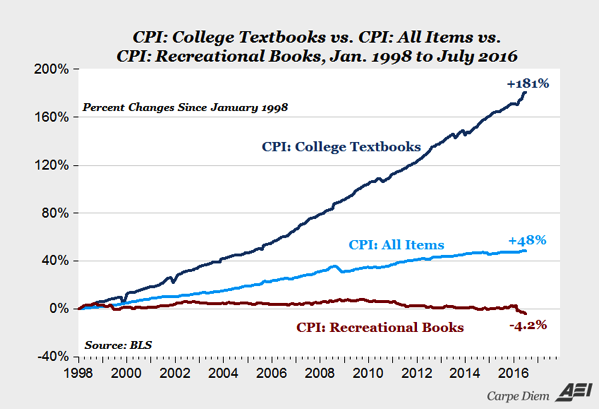
Via Econ Prof. Mark J. Perry:
The chart above shows in the percentage increases between January 1998 and July 2016 for: a) theoverall CPI for all items (+48%), b) the CPI for college textbooks (+181%), and c) the CPI for recreational books (-4.2%). In real terms, college textbook prices have increased by 90% while recreational book prices have fallen by more than 35%. (The increases in the real rates were calculated using the formula: (1 + Nominal Rate) = (1 + Real Rate) (1 + Inflation); and solving for the Real Rate.)
The huge divergence in book prices over times — college textbooks getting significantly more expensive while recreational books are getting significantly less expensive — would suggest that the college textbook publishers can’t really blame rising publishing costs for the exponential rise in college textbook prices. Rather, a better explanation would be that the college textbook market is insulated from the normal market forces that would lead to falling, not rising, book prices over time, like the recreational book market.
One way the textbook market is insulated from competition and market forces is that the professor, not the student, makes the decision on the textbook for a course, and it’s probably the case that many professors are unaware of the retail cost of the books they assign for their students. And once the professor decides on a textbook, there are no substitutes for the new edition of the book assigned. If a professor assigns Mankiw’s Principles of Economics textbook, students can’t substitute McConnell’sPrinciples of Economics textbook.
Another reason for skyrocketing textbook prices could be that they are being fueled by easy and cheap credit in the form of student loan debt, which now exceeds $1.36 trillion and has doubled in less than eight years, and tripled in the last decade! Students borrow money not just for college tuition and fees, but also to finance the purchase of textbooks that now routinely cost more than $300, and sometimes approach $400.
Read the rest here.